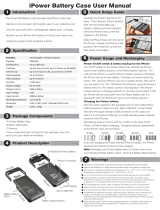
Copyright (c) 2005 Polycom Incorporated. All rights reserved. Polycom, the Polycom logo design and ViewStation are
registered trademarks, V
2
IU, ReadiManager SE200, PathNavigator, Global Management System, and iPower are
trademarks of Polycom, Inc. in the United States and various other countries. All other trademarks are the property of
respective owners
1Copyright (c) 2005 Polycom Incorporated. All rights reserved. Polycom, the Polycom logo design and
ViewStation are registered trademarks, PathNavigator, Global Management System, and iPower are trademarks of
Polycom, Inc. in the United States and various other countries. All other trademarks are the property of respective owners
members of other groups will not be returned as members of the secondary
groups. Hierarchical group membership is not tracked.
DEVICE ADMINISTRATION
1. Adding a device with ISDN capabilities will assume that the device has a
quad-BRI interface.
2. If an endpoint registers through the gatekeeper, though it will appear in the
global address book, it will not automatically receive the global address book
entries. To receive the global address book the endpoint must be provisioned
with the appropriate global address book configuration.
3. If an endpoint registers with the global address book server it will not
automatically be registered with the gatekeeper. Though it can be reached by
registered endpoints it cannot call other registered endpoints by alias without
registering with the gatekeeper.
4. An endpoint entered manually through the user interface must still be
provisioned to register with the gatekeeper or global address book services.
5. An endpoint which registers through either the gatekeeper or global address
book services may not automatically be claimed for device management if the
device has an administrative password until that password is entered through
the user interface.
6. In the Device Wizard you must clear the fields for Country Code, Area Code,
and number in order to uncheck the ISDN capability.
SCHEDULING
1. When creating a scheduled conference a higher bit rate can be selected for an
IP call than either the device policy or network topology would allow. When
the scheduled call launches the gatekeeper policies will apply by either
downgrading or rejecting the call.
2. The Outlook plugin and Web Scheduling control does not currently accept 8-
bit characters. Only characters in the 7-bit character set are currently valid.
3. When creating a recurring conference where only a portion of the future
scheduled conferences have conflicts will result in the non-conflicting
conferences being scheduled and the conflicting conferences not being
scheduled. No error message is returned to the user.
4. Users with iPower and VCON endpoints will need to download a plugin from
the Polycom Resource Center (PRC) to install on those endpoints. This will
enable the scheduling engine to auto-launch calls on those endpoints.
5. If endpoints are scheduled which are not part of a defined site, the conference
will not auto-launch the call with those endpoints. However, none of the
scheduling interfaces will indicate an error when those endpoints are
scheduled. All endpoints in an auto-launched call must be part of a defined
network to successfully start the conference.
6. Clients using the Jerusalem time zone on their local system must download a
patch from Microsoft to correctly compute daylight savings time for
scheduling calls.
7. When scheduling calls using the web-based scheduling control, emails will be
sent to all users who are associated to devices scheduled as well as guests
where the user details include a valid email address. Emails will not be sent
to resource owners which are part of the scheduled call. This functionality





